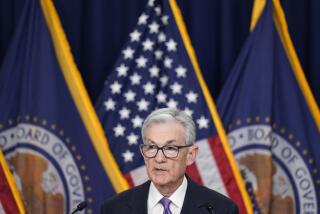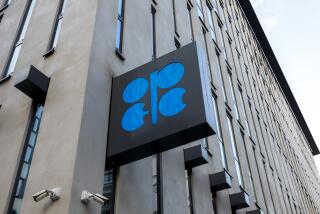OPEC Blames High Oil Prices on Dollar’s Slump
VIENNA — Blame still-high gasoline prices in part on the slumping dollar, oil exporting nations say.
OPEC on Wednesday said it was seeking to maintain current oil prices to compensate for the impact of the dollar’s plunge this year on cartel members’ purchasing power.
And though key members of the Organization of the Petroleum Exporting Countries, which will meet here today, indicated they don’t expect to reduce output in the near term, they warned that production cuts may loom in the first half of next year.
U.S. oil prices have mostly held above $30 a barrel since May, defying expectations that they would drop sharply after major combat in the Iraq war ended in spring.
OPEC, which supplies about one-third of the world’s oil needs, has trimmed official production quotas in recent months to support prices.
Influential Saudi Oil Minister Ali al-Naimi said current prices were justified by the dollar’s fall against other major currencies.
“Current prices are right,” Naimi said. “The dollar is weakening and purchasing power is quite weak so the price is OK.”
Because oil is priced in dollars worldwide, OPEC members effectively earn less as the dollar drops in value.
The buck’s slide continued Wednesday, as the euro rose to a record high of $1.21 from $1.208 on Tuesday. The dollar also fell against the yen, to 108.12 yen from 108.61 yen.
Currency traders have continued to push the dollar lower in recent weeks despite a string of strong U.S. economic data. Normally, a nation’s currency is bolstered by underlying economic strength. Some analysts say investors are focused on long-term threats to the dollar’s value, including the U.S. budget and trade deficits.
Naimi’s remarks indicate the dollar’s dive has reached the point where it is playing a central role in Saudi Arabia’s oil-price policy thinking.
In New York trading, near-term crude futures added 32 cents to $31.10 a barrel Wednesday. The price is up from $26.89 at the end of November 2002.
Since 2000, OPEC has targeted a $22-$28 band for an index of its crudes. That index has topped $28 in recent weeks.
Naimi declined to confirm that Saudi Arabia now was aiming for the high end of OPEC’s range, but said he wanted prices “within the purchasing power of the good, old dollar.”
“The fact that the dollar has dropped justifies the current price even if the price goes above the band,” said Abdulhafid Zlitni, head of Libya’s OPEC delegation.
“Effectively this would mean OPEC is raising the target price for its oil,” said consultant Roger Diwan of PFC Energy in Washington, D.C.
In October, Venezuelan President Hugo Chavez proposed that OPEC consider lifting its target range to $25-$32.
But for now, the cartel isn’t likely to further reduce production, analysts said. OPEC delegates said three Gulf Arab members -- Saudi Arabia, the United Arab Emirates and Qatar -- agreed at a meeting late Wednesday that no change was required now.
OPEC President Abdullah ibn Hamad al-Attiyah of Qatar said further action would probably be deferred until a meeting in January or February.
Algerian Oil Minister Chakib Khelil said he expected “tremendous” downward pressure on prices in the spring, without production cuts. “Demand will be less by 2.5 million barrels a day. Non-OPEC production will increase and Iraqi production is increasing,” he said.
Saudi Arabia’s Naimi preferred to leave open an element of doubt about today’s meeting, telling reporters: “You can never rule out anything until the meeting is over. There is concern for next year’s second quarter and some proactive action needs to be taken, whether at this meeting or the meeting before the [scheduled] March meeting.”
Further dollar losses before the next meeting could stiffen OPEC’s resolve to defend prices at the top of its $22-$28 range, analysts said.
More to Read
Inside the business of entertainment
The Wide Shot brings you news, analysis and insights on everything from streaming wars to production — and what it all means for the future.
You may occasionally receive promotional content from the Los Angeles Times.










